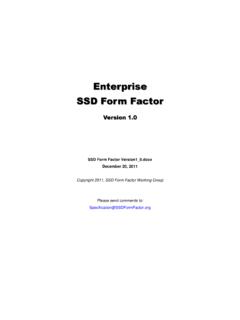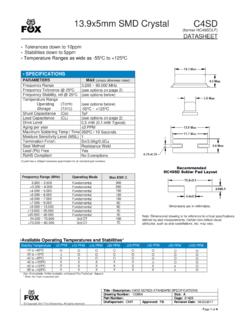Transcription of SSD Form Factor
1 Enterprise SSD form Factor Version SSD form Factor December 12, 2012 Copyright 2012 SSD form Factor Work Group, All rights reserved. Please send comments to Mark Myers Enterprise SSD form Factor 2 INTELLECTUAL PROPERTY DISCLAIMER THIS SPECIFICATION IS provided AS IS WITH NO WARRANTIES WHATSOEVER INCLUDING ANY WARRANTY OF MERCHANTABILITY, FITNESS FOR ANY PARTICULAR PURPOSE, OR ANY WARRANTY OTHERWISE ARISING OUT OF ANY PROPOSAL, SPECIFICATION, OR SAMPLE. NO LICENSE, EXPRESS OR IMPLIED, BY ESTOPPEL OR OTHERWISE, TO ANY INTELLECTUAL PROPERTY RIGHTS IS GRANTED OR INTENDED HEREBY. THE SSD form Factor WORK GROUP DISCLAIMS ALL LIABILITY, INCLUDING LIABILITY FOR INFRINGEMENT OF PROPRIETARY RIGHTS, RELATING TO IMPLEMENTATION OF INFORMATION IN THIS SPECIFICATION. THE SSD form Factor WORK GROUP DOES NOT WARRANT OR REPRESENT THAT SUCH IMPLEMENTATION(S) WILL NOT INFRINGE SUCH RIGHTS. The document revision is changed to Changes are: 1.
2 Changed 12V Tolerance to unspecified, and added an Implementation Note regarding power tolerance. Leaves Max continuous current to to match wider voltage range. 2. Changed text to show SFF-8639 as the approved normative document for mechanical specification. Section 3 is now informative, not normative. There is still an overview and primary drawings, but removed more detailed sections and reference SFF-8639. Specifically removed sections on intermateability, layouts (footprints), and blind mate & wipe, 3. Changed pin numbers to match approved SFF-8639 (SFF-8639, 2012). Specifically E17-E39 are relabeled S15-S28, E17-E25. No change in pin placement, aligning pin label with SFF-8630 (SFF-8630, 2012). 4. Changes to align with SFF-8630 (SAS Multilink). Removed references to SAS Multilink using SMBus, , or Act2. These changes are only in pin list tables. 5. Added multiple Extended Capability enumeration fields to Section This allows out of band discovery of Dual Port support, RefClk extensions, SM-Bus Temp sensor, Active/Passive mode.
3 6. Added description to improve clarity, Section and , added P-Init to Figure 29. 7. Editorial changes, including updating references and bibliography. Enterprise SSD form Factor 3 Table of Contents 1 OVERVIEW .. 6 Overview .. 6 Goals .. 6 Technical Summary .. 6 Flexible Drive Backplane option .. 7 Scope .. 8 Outside of Scope .. 9 2 SIGNAL LIST .. 10 Signal Lists .. 10 Connector pin out .. 12 PRSNT# - Presence Detect and IfDet# - Interface Detect Signal Definition .. 14 DualPortEn# - PCIe Dual Port Enable .. 14 Reserved(WAKE#/OBFF#), Reserved(ClkReq#/DevSLP) .. 15 ePERst[1:0]# - PCIe Reset .. 15 RefClk[1:0][+/-] Enterprise PCIe Clocks .. 15 Activity - Activity indication signal .. 15 3 CONNECTOR MECHANICAL .. 16 Connector Mechanical Drawing notes .. 17 Connector Plug Mechanical 17 Connector Plug Mechanical Drawings - Details .. 19 Connector Receptacle Mechanical Drawings .. 21 Cable Retention Mechanical Drawings .. 22 4 HOT PLUG AND REMOVAL.
4 27 Limit current inrush .. 28 Detecting Enterprise PCIe SSD Insertion/Removal .. 29 PCIe Hardware and Reset System Requirements .. 29 Software Implications of Hot Swap (Informative) .. 31 5 DUAL PORT OPERATION .. 33 Dual Port Mode (implications of DualPortEn#) .. 34 6 SM-BUS OPERATION .. 35 Simple Accesses to Vital Product Data (VPD) .. 35 Extended SM-Bus management .. 35 7 ELECTRICAL (POINTER TO OTHER SPECIFICATIONS) .. 36 Electrical Channel .. 36 Presence and Interface Detect .. 37 ePERst[1:0] .. 37 Power 12V .. 37 Power .. 38 8 REFERENCES AND BIBLIOGRAPHY .. 39 References .. 39 References Under Development .. 39 Formal Bibliography .. 39 9 SM-BUS - INFORMATIVE APPENDIX .. 41 Enterprise SSD form Factor 4 SM-Bus Vital Product Data (VPD) .. 41 SM-Bus Enterprise SSD Capability Definitions .. 42 SM-Bus Temperature Extended Capability.. 44 SM-Bus MCTP commands .. 45 10 SYSTEM USAGE INFORMATIVE APPENDIX .. 46 Pin usage across standards.
5 46 System Usage Examples .. 50 Connector Keying (Informative) .. 52 11 SPECIFICATION CONVENTIONS .. 54 Definitions .. 54 PCI Express (PCIe) .. 54 PCI Express Generation 2 (PCIe Gen2) .. 54 PCI Express Generation 3 (PCIe Gen3) .. 54 PCI Express x4 (PCIe x4) .. 54 SFF standards .. 54 SSD .. 54 Keywords .. 54 mandatory .. 54 may .. 54 optional .. 54 R, RSVD .. 54 reserved .. 54 shall .. 55 should .. 55 Enterprise SSD form Factor 5 Table of Figures Figure 1: Example configurations .. 7 Figure 2: Flexible Backplane Implementation .. 8 Figure 3: Signal List Summary (pin counts) .. 10 Figure 4: Signal List Table (defining specification) .. 11 Figure 5: Pin Out Drawing (Receptacle pin naming).. 12 Figure 6: Drive type - Pin decoding .. 14 Figure 7: Connector Mechanical Overview .. 16 Figure 8: Connector Examples .. 16 Figure 9: Connector Plug Mechanical Drawing Top View .. 17 Figure 10: Connector Plug Mechanical Drawing Drive Insertion View.
6 17 Figure 11: Connector Plug Mechanical Drawing Bottom View (outside of enclosure) .. 18 Figure 12: Connector Plug Mechanical Drawing End View (showing latch slot) .. 18 Figure 13: Connector Plug Mechanical Drawing Detail A (key) .. 19 Figure 14: Connector Plug Mechanical Drawing Detail C (key pins) .. 19 Figure 15: Connector Plug Mechanical Drawing Detail B (Tongue) .. 20 Figure 16: Connector Plug Mechanical Drawing Section D-D (Tongue cross section).. 20 Figure 17: Connector Plug Mechanical Drawing Drive Keep-out Area .. 21 Figure 18: Connector Receptacle Mechanical Drawing Drive insertion view .. 21 Figure 19: Connector Receptacle Mechanical Drawing Section E-E (Receptacle) .. 22 Figure 21: Cable Retention Mechanical Drawing Representative Cable Housing .. 24 Figure 22: Cable Release Clearance - Representative Cable Housing .. 25 Figure 23: Representative Cable Housing with flat ribbon cables .. 26 Figure 24: Hot Plug Current Inrush Limiting .. 28 Figure 25: System Reset Timing.
7 30 Figure 26: Reset Timing Details (PCI SIG CEM, 2007) .. 31 Figure 27: Single Port and Dual Port example .. 33 Figure 28: Typical SSD form Factor Channel .. 36 Figure 29: Power (12V) specifications .. 37 Figure 30: Power specifications .. 38 Figure 31: SM Bus Vital Product Data .. 41 Figure 32: SM Bus Capability Definition .. 42 Figure 33: Dual Port Extended Capability Definition .. 42 Figure 34: RefClk Extended Capability Definition .. 43 Figure 35: SM Bus Temperature Extended Capability Definition .. 44 Figure 36: Dual Port and Active/Passive Extended Capability Definition .. 45 Figure 37: Pin usage across Existing standards .. 48 Figure 38: Pin usage across Emerging 49 Figure 39: Backplane for Enterprise SSD (PCIe x4), SATA & SATA Express (Client PCIe) .. 50 Figure 40: Backplane for Enterprise SSD (PCIe x4), SAS & 51 Figure 41: Backplane for SAS X4, SAS & SATA .. 51 Figure 42 Cross Standard Connector Keying .. 53 Enterprise SSD form Factor 6 1 Overview Overview This specification defines the electrical and mechanical requirements for a PCI Express connection to the existing standard and disk drive form factors .
8 This is intended for PCIe connections to SSDs (Solid State Drives) for the enterprise market of servers and storage systems. This provides a new PCIe form Factor that is storage friendly, leveraging both the existing PCIe specification and the existing and drive mechanical specifications. This standard allows system designs that can support a flexible mix of new enterprise PCI Express drives, and existing SAS and SATA drives. Note: The References and Bibliography are listed at the end, in section 8 on page 39. The Specification Conventions are listed at the end, in section 11 on page 54. This includes the standard material such as the definition of Shall , Should , May , etc. and bibliographic material to reference specifications. Also included are definitions of terms such as PCIe , PCIe Gen 3 , PCIe x4 , SFF , and SSD . The bibliographic reference use the original author name, for example (SFF-8482, 2006) while the section give the current designator, for example EIA-966.
9 Goals The following are the characteristics of the product envisioned using this specification: PCIe1 connection to Enterprise Solid State Drives (SSDs). Standardize connector and form Factor but enabling innovation using the PCIe model. Fits in existing drive mechanical enclosures using a disk backplane. Supports both drive mechanical enclosures and drive mechanical enclosures. Support customer expectation for storage device: o Externally accessible & Hot Swappable (with surprise removal) o Support existing OEM s existing drive infrastructure (device detection and indicators) o Support existing OEM thermal architectures, and support for future enhancements. Support for both single port (typical servers), or dual port (typically storage systems). Meet projected system storage device performance requirements for systems introduced in the 2H 2011 to 2016 timeframe. Enables flexible system designs that support Enterprise PCIe Express SSDs and SAS or SATA drives using the same connector family, allow systems to support flexible mix of capacity (SAS or SATA hard drives) or Enterprise PCIe SSDs.
10 Technical Summary A technical summary of the SSD form Factor Working Group is: Focus is on connector which is supported in both the existing and form factors . Supports the drive (SFF-8223, 2006) specification2 unchanged, or supports the drive (SFF-8301, 2010) specification unchanged. Compatible with existing SAS connector (SFF-8680, 2012). Meaning the connectors allow interoperation, see Section 10. For example a new backplane receptacle would accept new or existing drives. The connector is doubled sided extension to existing SAS connector. New pins are pitch across the complete B-side and on top of SAS key. Support for PCIe x4 (Gen2 and Gen3) signaling. References PCIe specifications for high speed electrical specifications unchanged. The electrical channel is assumed to be similar to SAS-3 channel short board trace, longer cable, trace on storage backplane, SSD. 1 Definition of PCIe and reference specification are included in section 8 on page 40 2 Definition of SAS, SATA, SFF and reference specifications including official designations (EIA, ANSI, INCITIS numbers) are included in section 8 on page 40 Enterprise SSD form Factor 7 25W connector limit, with 12V only delivery.





